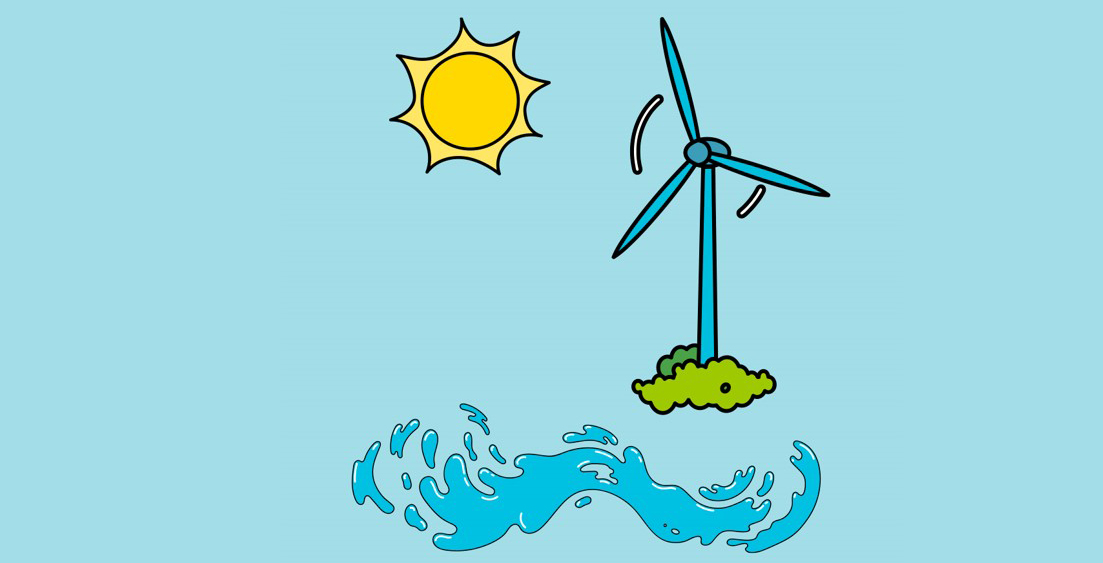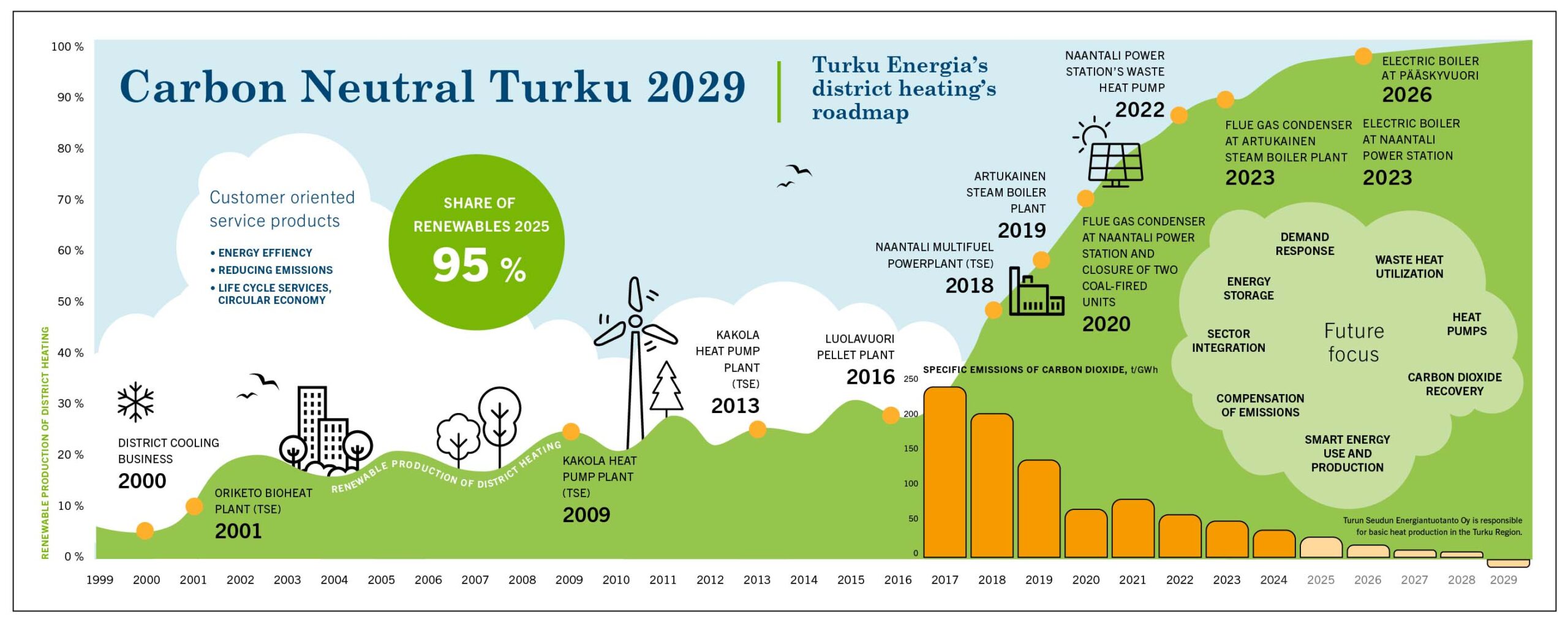Origin of energy
Turku Energia has ambitiously invested in the transition from fossil fuels to renewable and zero-emission energy production for more than two decades. The last fossil energy sources will be replaced by the utilisation of waste heat and electrical production, such as with the Pääskyvuori electric boiler currently under construction.

Origin of electrical energy
Turku Energia sells all its electricity to the power exchange. Likewise, all of the energy that Turku Energia sells is purchased from the power exchange. In 2024, the percentage of electricity produced by Turku Energia itself accounted for about 24.2% of all the electricity it sold. Renewable electricity accounted for approximately 94.9% of the electricity produced by Turku Energia.
We produce renewable electricity with water and wind power in our affiliated company, which includes the Svartisen's hydroelectric power plant, Kolsin Voima's hydroelectric power plants and Suomen Hyötytuuli's wind power plants. We also produced electricity in production plants owned by Turku Energia's affiliated companies, including the Naantali power plant owned by Turun Seudun Energiantuotanto Oy (TSE).
Turku Energia also has numerous purchase agreements with different power plants, such as the Högsåra wind farm and Kiskonjoki hydropower plant.
The distribution of origins was calculated on the basis of the national residual mix reported by the Finnish Energy Authority and the guarantees of origin obtained by Turku Energia. Guarantees of origin are granted for electricity produced from renewable energy sources. This means that guarantees of origin are also a proof to the customer that the electricity is produced from renewable energy sources.
The residual mix contains electricity generated by fossil fuels and nuclear power as well as its share of renewal electricity-based electricity, which has not been sold separately with guarantees of origin.
The Finnish Energy Authority publishes the residual mix annually in June. The figures are then updated on our website.
Origin of electrical energy in 2023
Electricity sold to Turku Energia's customers in 2023 by source:
- Renewable energy sources 49.2%
- Fossil energy sources and peat 10.4%
- Nuclear power 40.4%
Average specific CO2 emissions from electricity production: 70.11 g/kWh
Quantity of nuclear fuel used: 1.33 mg/kWh
Electricity with unverified origin sold by Turku Energia by origin:
- Renewable energy sources 17.3%
- Fossil energy sources and peat 17%
- Nuclear power 65.7%
Average specific CO2 emissions from electricity production: 114.04 g/kWh
Quantity of nuclear fuel used: 2.17 mg/kWh
Origin of district heating and cooling in 2024
In 2024, 89.4% of district heating sold by Turku Energia was produced with renewable energy sources, electric boilers and waste heat. A more detailed breakdown of the fuels used is shown in the figure below.
The district heat of Turku Energia is mainly produced at the Naantali power plant, Oriketo bioheat plant and Kakola heat pump plant owned by our affiliated company, Turun Seudun Energiantuotanto Oy (TSE), as well as at Turku Energia's Artukainen steam-heat plant. In addition, Turku Energia procures approximately 3% of the total district heat requirement by procuring heat generated through the use of biofuels and waste heat from its co-operation partners and customers. During peak loading times in freezing winters and when there are disturbances in the operation of the base generation plant, the Turku Energia Luolavuori pellet heat plant and oil-fired heating plants are used in addition to the facilities mentioned previously.
The procurement of energy wood used in the energy production of Turku Energia and our affiliated companies meets the sustainability criteria of EU legislation. Energy wood is procured from operators who can present certificates to demonstrate that the raw materials have been procured in compliance with the principles of sustainable forest management and that their use supports climate objectives. Energy wood includes, for example, chips from roundwood and forest residue chips. Forest industry residues and side streams, such as saw dust and bark, have minor impacts on the environment and biodiversity.
TSE’s Naantali power plant also incinerates recycled fuel (SRF), which is produced from non-recyclable commercial, industrial and construction waste. As support fuel, the Naantali power plant uses asphalt and milled peat. The use of coal at the plant is ending, and at this point, it is only used and stored in preparation for exceptional situations. Furthermore, in 2023, district heating was produced at the Naantali power plant with an electric boiler, which replaced some of the district heating formerly produced by burning fuel.
As the share of renewable energy increases, district heating emissions are constantly decreasing. In 2024, the specific emissions of district heating in the Turku region were 31.6 kgCO2/MWh per energy sold. Emissions have been calculated using the benefit-sharing method.) Last year, Turku implemented a carbon footprint calculation for all emissions in 2023 and 2024.
District heating customers can purchase 100% renewable district heating from Turku Energia using Ekotakuu Bio and Ekotakuu Kakola products. The products are included in the Registry of guarantees of origin for heating and cooling maintained by the Energy Authority. All our cooling solutions are 100% renewable, and specific emissions are 0 kgCO2/MWh per energy sold.
Fuels for heat procurement in Turku region 2023
Emissions from district heating in the Turku region
(Emissions from the plants of Turku Energia and its affiliated company Turun Seudun Energiatuotanto Oy. Emissions have been calculated using the benefit-sharing method)
Particulate emissions 2020–2024, t
Specific emission of particles, t/GWh
Nitrogen oxide emissions 2020–2024, t
Specific emission of nitrogen oxides, t/GWh
Sulfur dioxide emissions 2020–2024, t
Specific emission of sulfur dioxide, t/GWh
Carbon dioxide emissions 2020–2024, t
Specific emission of carbon dioxide, t/GWh
Our roadmap to carbon neutrality
Turku Energia has made determined investments in renewable and carbon-neutral energy production. The largest investments have already been made, but in 2023, we decided to invest in a new electric boiler in Turku. On our final sprint towards carbon-neutrality in energy production, we will utilise not only electric boilers but also e.g. waste heat and energy storage in accumulators.
